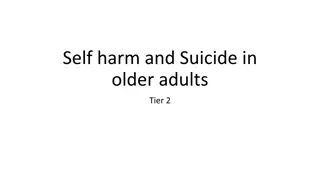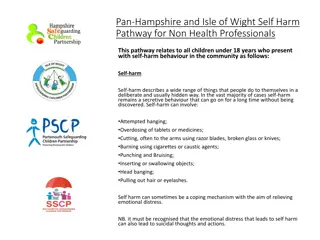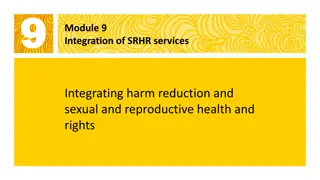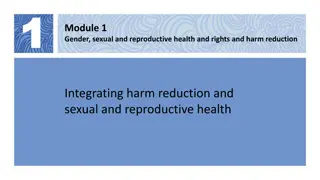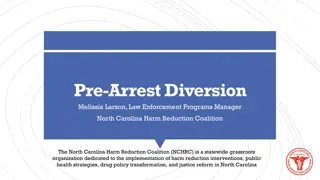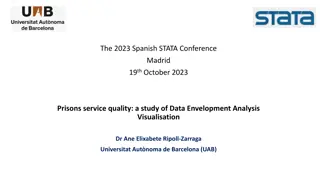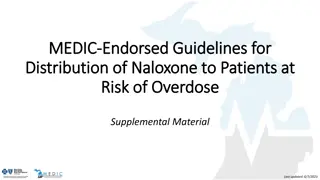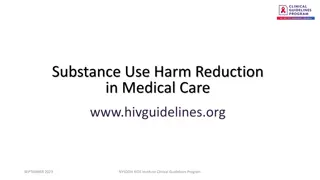Insights on Harm Reduction Interventions in European Prisons
Explore findings on mortality rates, drug use prevalence, and interventions in European prisons. Discover the impact of drug-related deaths, including NPS use, and the effectiveness of interventions like OAT and harm reduction strategies. Learn about the challenges and opportunities in addressing drug issues among incarcerated individuals.
Download Presentation

Please find below an Image/Link to download the presentation.
The content on the website is provided AS IS for your information and personal use only. It may not be sold, licensed, or shared on other websites without obtaining consent from the author. Download presentation by click this link. If you encounter any issues during the download, it is possible that the publisher has removed the file from their server.
E N D
Presentation Transcript
Harm reduction interventions in prison in European countries: focus on mortality Linda Montanari, Liesbeth Vandam, Iciar Indave, Isabelle Giraudon European Monitoring Centre for Drugs and Drug Addiction 10-11 October 2023 Drug Related Deaths expert meeting, EMCDDA, Lisbon and online
Drug and Prison in Europe Lifetime prevalence of drug use Drug Max. % Max% Prison population 87% General population 45% Cannabis Cocaine 75% 11% Ampheatamines 47% 8% Heroin 29% 0.9% Proportion of people in prison for drug law offence Sources: EMCDDA, FONTE data 2022; Aebi, M. F. and Tiago, M. M. (2022), Council of Europe annual penal statistics SPACE I: prison populations survey 31/1/2021, Council of Europe, Strasbourg 2
Drug injection and women EQDP data from six countries (CZ, LV, LT, SI, PT, ES) 4
Mortality among people in prison Mortality inside prison Mortality after prison release EU 10.5 deaths for suicide * 10000 prison population (VS 1.5 in general population) 78% of deaths are violent deaths 1 in 10 of those violent deaths are due to intentional or accidental drug overdose or intoxication 5 EMCDDA (2021), Prison and drugs in Europe: current and future challenges, Luxembourg.
Deaths related to the use of NPS in prison Deaths directly or indirectly related to NPS Germany, Latvia, Poland, UK 79 deaths in England and Wales, between June 2013 and September 2016- known or strongly suspected to have taken NPS before death, or where their NPS use was a key issue during their time in prison Of 79 deaths, 56 were self-inflicted Important role of NPS, particularly synthetic cannabinoids, in aggravating existing mental health conditions or mental states associated with self-harm 6
Drug related interventions in prison: evidence Scarce evidence because of little research and monitoring Similar to community: OAT and harm reduction Overview of the evidence base on the effectiveness of drug-related interventions in prison for prevention of postrelease mortality 7 EMCDDA (2021), Prison and drugs in Europe: current and future challenges, Luxembourg.
Availability of drug related interventions in prison setting (n. countries/ out of 29) (2021 or most recent year) EMCDDA (2021), Prison and drugs in Europe: current and future challenges, Luxembourg. Updated 2023 8
Delay and lack of coverage of HR in prison EMCDDA (2021), Prison and drugs in Europe: current and future challenges, Luxembourg. 9
Needle and syringe programmes Country Year of introduction 1996 1995 Implementation/Modality Germany Luxembourg 1 prison and 5 machines On request Provided by nurse Harm reduction kit with 2 syringes No activity No activity All prisons Distributed by health staff Hygienic kits, with syringes, disinfecting towels, distilled water, condom Portugal Romania Spain 2007 2009 1997 Source: 2018 EMCDDA Prison Workbooks 10
Take home naloxone: 7 countries Country Estonia France Implementation 2015 - coverage low and decreased to none in 2020-21. 2016 officially available 2019 confirmed by MoH roadmap for preventing overdose of opioids 2017 - pilot project Bavaria with training show possible to train inmates 2019 - first naloxone training - pilot project supported by MoJ 2022 - Prisons informed on possibility for training - plan to do more training It can be prescribed to persons at risk of overdose Suggested training +naloxone provision for addiction and homeless services 2020-2025 officially introduced in the National Prevention Plan. Available in one prison (pilot project) for people on release with distribution kits 2021 provided to inmates in prison or upon release (in 2021 no naloxone kits issued). 2018 five-year MoH project to reduce risk of overdoses upon release Equipment of people in prisons with naloxone nasal spray before release By 2022 all Norwegian prisons have completed training On-going plans to implement in 17 probation offices, funding unclear. Germany Ireland Italy Lithuania Norway 11
Documenting models of care for the elimination of hepatitis in prison 1. Oca a (ES): comprehensive harm reduction package provided to drug users 2. Luxembourg (LU): test & treatment activities 3. Milan (IT): HAV and HBV vaccination for people in prison and prison staff Berlin Luxembourg 4. Berlin (DE): interventions addressing viral hepatitis for females in prison Milano Montpellier Oca a 5. Montpellier (FR): guaranteeing continuity of HCV care and treatment after prison release Set up of an Advisory Board Exploratory questionnair es Interviews in five selected prisons
Barriers to implementation Online focus group with prison experts- EURORPIS network Countries: Austria, Belgium, Bulgaria, Cyprus, France, Germany, Ireland, Lithuania, Spain, Spain-Catalonia socio-ecological model LEVEL Individual BARRIERS Adverse attitude of HCWs and prison staff toward the provision of care for PLP PLP reluctance of being tested or treated Societal Lack of insurance coverage Lack of strategy plan/guidelines for the elimination of hepatitis in prison Organisational Responsibility for healthcare provision in prison Lack of human resources Fragmented management HCV treatment eligibility linked to the length of stay Interoperability between prison and community health information systems Communication Linkage to care post-release Lack of timely and effective sharing of information between stakeholders
Some final thoughts Drug use and related problems represent an important issue in prison population Population in prison is in continuous contact with Risk of mortality is high especially after prison release Harm reduction measures to prevent mortality exist, but they are still not scarcely implemented in prison Identification of models of care and barriers to address may help addressing the death risk in prison population 14
Thank you! linda.montanari@emcdda.europa.eu 15






